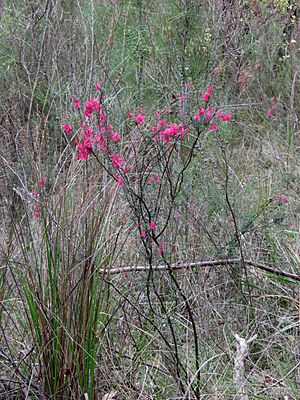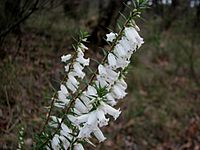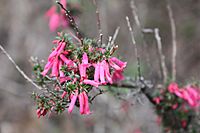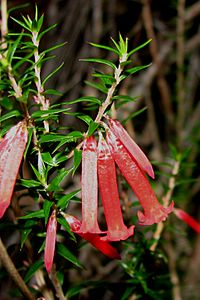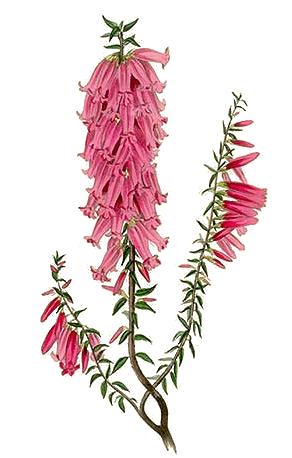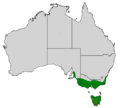Common heath facts for kids
Quick facts for kids Common heath |
|
|---|---|
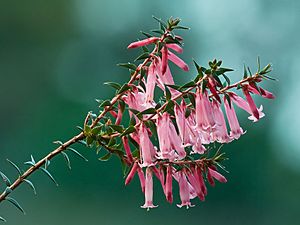 |
|
| Scientific classification | |
| Genus: |
Epacris
|
| Species: |
impressa
|
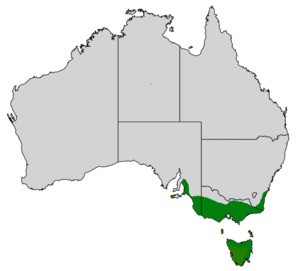 |
|
| Synonyms | |
|
Epacris tomentosa Lindl. |
|
The Common Heath (Epacris impressa) is a beautiful plant. It belongs to the heath family and grows naturally in southeast Australia. You can find it in Victoria, Tasmania, South Australia, and New South Wales. A French botanist named Jacques Labillardière first found and described this plant in 1793. There are different types of common heath, but they are all considered the same species.
It usually grows as a small bush, about 0.5 to 1 meter (1.5 to 3 feet) tall. It has small, stiff leaves. Its tube-shaped flowers can be red, pink, or white. They bloom from late autumn to early spring. Birds like Honeyeaters, especially the eastern spinebill, love to drink nectar from these flowers. After a bushfire, the common heath can grow back from its seeds or from its roots.
People really like to grow common heath in gardens. It was first grown in England in 1825. More than seventy special types (called cultivars) have been created, but most of them are not around anymore. A pink-flowered type, often called "pink heath," is the official flower symbol of the state of Victoria. It can be a bit tricky to grow new common heath plants. This has made it harder to use them in gardens or for replanting areas. It grows best in soil that drains well but stays moist, and in a spot that gets some shade.
Contents
What Does the Common Heath Look Like?
The common heath grows as a woody bush that stands upright. It can sometimes reach 2 to 3 meters (6.5 to 10 feet) tall. But usually, you will see plants that are about 0.5 to 1 meter (1.5 to 3 feet) tall. Its branches are stiff and have small leaves. These leaves have prickly, pointed tips and are about 8 to 16 millimeters (0.3 to 0.6 inches) long.
The flowers mostly appear between late autumn and early spring. They grow in thick bunches along the stems. The flowers can be white, pink, or red. They are about 1 to 2 centimeters (0.4 to 0.8 inches) long and are narrow and tube-shaped. They have five small dents at their base. The flower's petals are joined at the bottom to form a tube. The ends of the petals form five small tips at the top. There are five sepals (leaf-like parts) at the base of the flower. Inside the tube, there is a central part called a style. This style connects the stigma at the top to the ovary at the bottom. The sweet nectar is also found in the ovary.
You can often see different colored flowers growing close to each other. The fruit is a small, round capsule, about 3.5 millimeters (0.14 inches) wide. It starts green, then dries out and splits open. This releases many tiny seeds.
Where Does the Common Heath Grow?
The common heath is often found near the coast and in nearby hills. It grows from Kangaroo Island and the southern Mount Lofty Ranges in South Australia. It spreads across southern Victoria, reaching the Grampians and the Little Desert. It also grows north into southern New South Wales, as far as the Clyde River. You can also find it widely across Tasmania.
This plant can grow in many different places. These include sandy or clay heathlands, woodlands with many herbs and shrubs, and dry forests. It also grows in thickets near rivers, on rocky hillsides, and on rocky outcrops. It can be found at high altitudes, up to 1,200 meters (3,900 feet) in some mountains.
Different Flower Colors
Scientists have studied common heath plants and found different types based on their flowers:
- White flowers: These have shorter tubes (9-12 mm long) and red-purple pollen parts. They usually grow in sunny places and are found all over where the plant grows.
- Pink flowers: These have longer tubes (12-19 mm long) and cream-white pollen parts. They prefer shadier spots and are also found everywhere.
- Long scarlet flowers: These have orange-red flowers with long tubes (15-19 mm long) and cream-white pollen parts. They are found in places like Wilsons Promontory in Victoria.
- Broad pink or white flowers: This type is from the Grampians in Victoria. These plants are taller, often reaching 2 meters (6.5 feet).
Sometimes, the long-pink and short-white types grow very close together. The pink ones tend to flower in winter, and the white ones in spring. Even though they look different, they can still pollinate each other.
How Does the Common Heath Live?
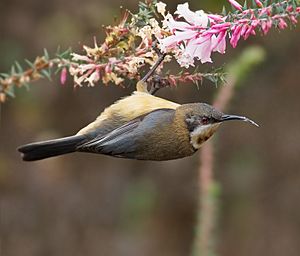
Honeyeater birds, like the eastern spinebill, love to visit the flowers. As the bird drinks nectar, pollen sticks to its head feathers. This pollen is then carried to other flowers, helping the plants to cross-pollinate. In Tasmania, eastern spinebills arrive when common heath flowers bloom and leave when they are done. Other honeyeaters also visit these flowers sometimes.
Insects like the Australian painted lady butterfly and bees also visit the white flowers. Sometimes, introduced bumblebees will make a hole at the base of the flower to get nectar. Then, honeybees can also use these holes.
The common heath can get sick from a plant disease called Phytophthora cinnamomi. However, some young common heath plants have been able to grow back in areas that were affected by this disease.
After a bushfire, the common heath can regrow from its seeds or from its roots. After big fires in 1983, many common heath seedlings appeared. They even started flowering just two years after the fire.
The roots of common heath plants have special fungi living on them. These fungi help the plant get nutrients from the soil.
Growing Common Heath in Your Garden
The common heath was first grown in gardens in England in 1825. It was popular, and many different types were developed. However, most of these special types have now disappeared.
These plants grow best in soil that is moist but drains well and is a bit acidic. Adding peat to the soil can help. You can grow them in coastal gardens if they are in a sheltered spot. They usually need some shade. Once they are settled, they can handle short dry periods. As the plants get older, they might look a bit messy. But if you prune them hard after giving them fertilizer and water, they will grow back bushier. Common heath plants can be short-lived and hard to move once they are growing. However, they can be easily grown in pots.
It can be tricky to grow new common heath plants from seeds or cuttings. This makes it harder for plant nurseries to produce many of them. But if seeds are heated or treated with smoke water, they sprout much better. For cuttings, it's best to use new growth tips taken six weeks after flowering.
Popular Types of Common Heath
Here are some special types of common heath that people like to grow:
- 'Bega'
This type comes from Bega and has bright red flowers. It grows to about 60 centimeters (2 feet) tall. It is known as one of the easier types to grow.
- 'Cranbourne Bells'
This type has double flowers, meaning they have more petals than usual. The flower buds are pink and turn white when they open. This plant was found naturally near the Royal Botanic Gardens, Cranbourne in Victoria. Double-flowered common heath plants are quite rare.
- 'Spring Pink'
This type has deep pink flowers on long spikes. It blooms in spring and grows to about 60 centimeters (2 feet) tall.
Victoria's Floral Emblem
In 1951, it was decided that the pink form of the common heath, known as "pink heath," would become the official flower symbol for the state of Victoria. Victoria was the first Australian state to choose a floral emblem. The official announcement was made on November 11, 1958.
The pink heath has been featured on Australian stamps. It was on a 13-cent stamp in 1968 and a 70-cent stamp in 2014. You can also see the pink heath on the Victorian driver's license. In 1973, a picture of the pink heath was added to the coat of arms for Victoria.
Images for kids


